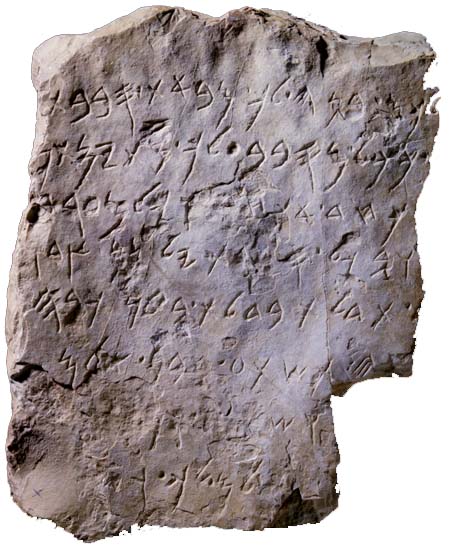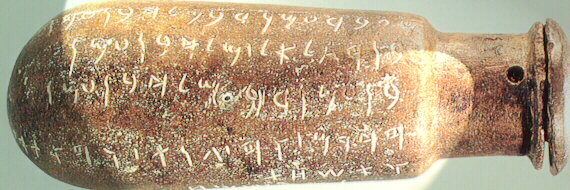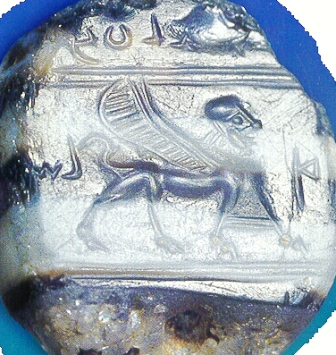Examples of writing
Citadel Inscription from Rabbat Ammon (9th century BC)

l. 1: M]LKM BNH LK MB′T SBBT [
l. 2: ] KKL MSBB ‘LK MT YMTN [
l. 3: ] KḤD ′KḤD[.] WKL M‘R[.]B [
l. 4: ] WBKL S[D]RT YLNN ṢDḲ[M
l. 5: D]L TDLT BDLT BṬN KBH [TKBH
l. 6: ]H TŠT‘ BBN ′LM [
l. 7: ]WŠLWH WN[...]
l. 8: ] ŠLM LK WŠ[
"M]ilkom built for you {or: "... Milkom: 'Build'} the entrances all around [
] because anyone who presses you from every side shall surely die [
] surely I shall wipe out, and anyone who will get upset [
] among all the columns shall the righteous dwell [
] you will hang up {or: it will be hung up} on the inside doors. You will surely [destroy
] you will be feared among the gods [
] and safety and... [
] peace to you and... ["
Discovered in the citadel of Amman in the mid '60s of the last century, this inscription mentions parts of a building, and shows polemic and punitive overtones. Therefore, it was interpreted as a monumental inscription for the dedication of a building (a temple? the citadel itself?) produced according to the rules of this genre, as was common across the Ancient Near East. Others proposed that here we are dealing with the transcription of a first person oracle, uttered by Milkom himself, the 'national' God of Ammon, and directed to the king: if we follow this proposal, through a human mouthpiece, Milkom had promised his protection to the king and guaranteed him safety from every enemy, speaking in style and forms often found in all Near East prophetical literature. For his part, the king, seeing everything accomplished as the oracle assured, built and dedicated a memorial, ordering to insert in the inscription for the dedication the historical report of what happened, along with a mention of the words actually spoken by the god. If such were the case, then, in l. 1, before the name of the god, we could possibly read: "so speaks/spoke" or "oracle/word of".
Bronze bottle from Tel Siran (7th century BC)

l. 1: M‘BD ‘MNDB MLK BN ‘MN
l. 2: BN HṢL′L MLK BN ‘MN
l. 3: BN ‘MNDB MLK BN ‘MN
l. 4: HKRM WHGNT WH′TḤR
l. 5: W′ŠḤT
l. 6: YGL WYŠMḤ
l. 7: BYWMT RBM WBŠNT
l. 8: RḤQT
"The works of ‘mndb, king of the sons of Ammon,
son of Hṣl′l, king of the sons of Ammon,
son of ‘mndb, king of the sons of Ammon,
(which are) the vineyard and the garden and the channel (?)
and the cistern,
may they give joy and happiness
for many long days and years
to come"
This bronze bottle, unearthed near Amman in 1973, lists some of the constructions built by ‘mndb, king of the Ammonites, invoking joy and prosperity upon and through them. Although the text is basically clear, its specific functions can only be guessed at. The second ‘mndb, mentioned in l. 3, as the grandfather of the first one, was the Ammonite ruler who revolted against Assurbanipal around the middle of the 7th century BC. Therefore, the bottle and the constructions it lists must be dated to the end of that century.
Seal of B‘lš‘, king of Ammon (first quarter of 6th century BC)

l. 1: [L]B‘L[Š‘]
l. 2: MLK
l. 3: [BN ‘MN?]
"(Belonging) [to] B‘l[š‘]
king
[of the sons of Ammon?]"
The seal bears the name of a king of Ammon, B‘lš‘. This name is attested also in Jer 40, 13-14, where a B‘lš‘ is mentioned as the man behind the assassination of Gedalyah, governor of Judah sponsored by the Babylonians after the fall of Jerusalem. He must have ruled then approximately in the first quarter of the 6th century BC. Right at the centre, the winged and skirted sphinx betrays Egyptian influence. The s-shaped tail, curving upwards, seems instead typical of Ammonite seal impressions.